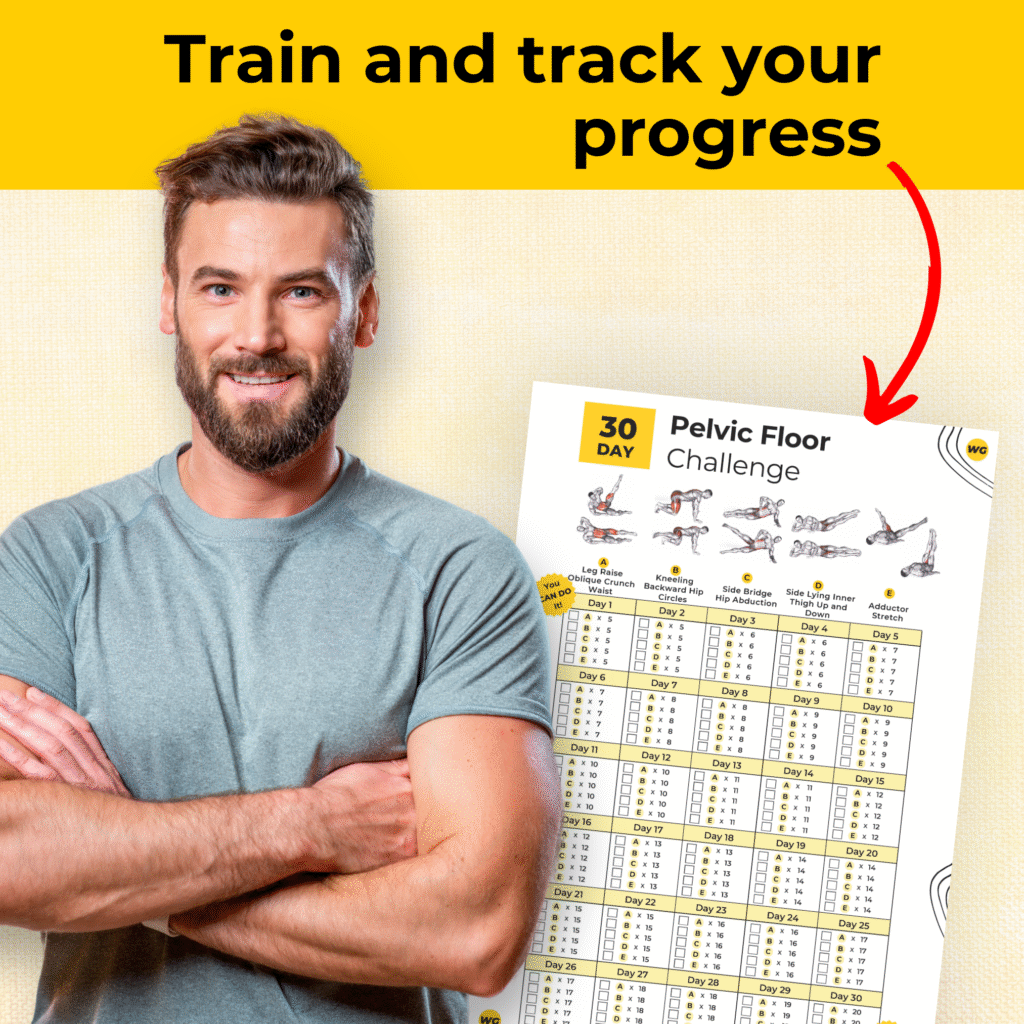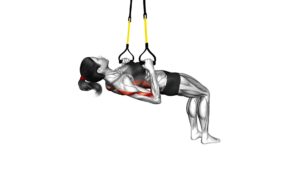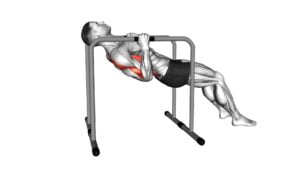Inverted Row Bent Knees (female) – Video Exercise Guide & Tips

Are you looking for a challenging and effective exercise to target your back muscles? Look no further than the inverted row bent knees.
Watch This Exercise Video
This exercise, specifically designed for females, is a great way to build strength and improve posture.
In this video exercise guide, we will show you the proper form and technique, equipment options, modifications, and common mistakes to avoid.
Get ready to take your fitness to the next level with the inverted row bent knees!
Key Takeaways
- The Inverted Row Bent Knees exercise strengthens back muscles and improves overall upper body strength for females.
- It enhances posture and targets muscles in the upper body.
- Proper hand placement and grip, along with maintaining a neutral wrist position, are essential for the exercise.
- The exercise can be performed at home or in the gym, with various equipment options available, including suspension trainers, resistance bands, Smith machines, and barbells.
Benefits of the Inverted Row Bent Knees for Females
The benefits of the Inverted Row Bent Knees for females include strengthening your back and improving overall upper body strength. This exercise is a cost-effective way to achieve these benefits, as it can be performed using minimal equipment. Proper alignment is crucial when performing the Inverted Row Bent Knees to ensure maximum effectiveness and prevent injury.
By engaging your back muscles, the Inverted Row Bent Knees helps to strengthen the muscles that support your spine. This can improve posture and reduce the risk of back pain, which is particularly important for females who may be more prone to these issues. Additionally, this exercise targets the muscles in your upper body, including the shoulders, arms, and chest. By consistently incorporating the Inverted Row Bent Knees into your workout routine, you can develop greater upper body strength and enhance overall muscular endurance.
To ensure proper alignment, start by lying flat on your back with your knees bent and feet planted firmly on the ground. Grab a sturdy bar or suspension trainer, keeping your hands shoulder-width apart and palms facing up. Engage your core and squeeze your shoulder blades together as you pull your chest towards the bar or handles. Maintain a straight line from your head to your knees throughout the movement. It's important to avoid excessive swinging or arching of the back, as this can lead to strain or injury.
Proper Form and Technique for the Inverted Row Bent Knees
To perform the Inverted Row Bent Knees with proper form and technique, it's important to focus on two key points: hand placement and grip, and engaging the back muscles.
Start by positioning yourself underneath a bar, with your hands slightly wider than shoulder-width apart and palms facing away from you.
Ensure a strong grip and engage your back muscles as you pull your chest towards the bar.
Hand Placement and Grip
Place your hands shoulder-width apart on the bar and grip it firmly to maintain stability during the Inverted Row Bent Knees exercise. Proper hand placement and grip are essential for performing this exercise effectively and minimizing the risk of injury. Here are some tips to help you achieve the right hand position:
- Position your hands slightly wider than shoulder-width apart to engage more muscles in your upper body.
- Ensure your palms are facing down, and your fingers are wrapped securely around the bar.
- Avoid using an excessive grip strength that may lead to forearm fatigue.
- Keep your wrists in a neutral position, neither flexed nor extended.
- Maintain a consistent grip throughout the exercise, with no slipping or readjusting.
Engaging the Back Muscles
To engage your back muscles properly and execute the Inverted Row Bent Knees exercise with correct form and technique, focus on maintaining a strong and stable position throughout the movement.
Begin by lying on your back under a bar or suspension trainer, with your feet flat on the ground and your knees bent.
Grab the bar or handles with an overhand grip, slightly wider than shoulder-width apart. Keep your body straight, engaging your core muscles.
As you pull yourself up towards the bar or handles, focus on squeezing your shoulder blades together and engaging your back muscles. Avoid shrugging your shoulders or using your arms to pull yourself up.
Lower yourself back down with control and repeat for the desired number of repetitions.
Equipment Options for Performing the Inverted Row Bent Knees
Now let's talk about the equipment options for performing the inverted row bent knees. Whether you choose to do this exercise at home or in a gym, there are pros and cons to consider.
The cost and accessibility of the equipment are also important factors to keep in mind. Additionally, there are variations and modifications that can be made to suit your fitness level and goals.
Home Vs. Gym
You can perform the Inverted Row Bent Knees exercise at home or in the gym using various equipment options. Here are the benefits of each:
- Home Workouts
- Convenience: You can exercise anytime without having to leave your house.
- Cost-effective: No need to pay for a gym membership.
- Privacy: You can workout without feeling self-conscious.
- Customizability: You can choose the equipment that suits your needs and budget.
- Comfort: You can exercise in a familiar and comfortable environment.
- Benefits of Gym Memberships
- Variety of equipment: Gyms offer a wide range of equipment options for different exercises.
- Professional guidance: Trained instructors can provide guidance and help you with proper form.
- Motivation: Being surrounded by other like-minded individuals can boost your motivation.
- Social interaction: Gyms provide an opportunity to meet new people and make workout buddies.
- Accountability: Having a gym membership can help you stay committed to your fitness goals.
Whether you choose to workout at home or in the gym, the Inverted Row Bent Knees exercise can be a great addition to your fitness routine.
Cost and Accessibility
Performing the Inverted Row Bent Knees exercise can be done using various equipment options, allowing for different levels of cost and accessibility. One of the most cost-effective ways to perform this exercise is by using a suspension trainer, such as TRX. Suspension trainers are portable and can be easily set up at home or in a gym.
Another affordable option is using resistance bands, which come in different resistance levels and can be attached to a door frame or a sturdy anchor point.
If you have access to a gym, you can use a Smith machine or a barbell set up at a low height. These options provide stability and allow you to adjust the difficulty level by adding or removing weight plates.
Additionally, if you don't have access to any of these equipment options, there are alternative exercises you can do to target the same muscle groups, such as bent-over rows with dumbbells or a seated cable row machine.
Variations and Modifications
To explore variations and modifications for performing the Inverted Row Bent Knees, continue discussing the equipment options mentioned in the previous subtopic. Here are some options for modified inverted row techniques:
- Use resistance bands: Attach resistance bands to a stable anchor point and loop them around your shoulders or under your feet for added resistance.
- Use a suspension trainer: Utilize a suspension trainer like TRX to perform the inverted row. Adjust the straps to control the difficulty level.
- Elevate your feet: Place your feet on a bench or step to increase the challenge and engage your upper back muscles even more.
- Change grip width: Experiment with different grip widths, such as wide or narrow, to target different muscles in your back.
- Single-arm inverted row: Perform the inverted row using only one arm at a time to work on unilateral strength and stability.
Modifications and Progressions for the Inverted Row Bent Knees
To modify and progress the Inverted Row Bent Knees exercise, start by adjusting the height of the bar. Lowering the bar makes the exercise easier, while raising it increases the difficulty. This modification allows you to gradually build strength and work towards performing the exercise at a more challenging level.
Another modification you can make is by changing the grip width. A wider grip engages the muscles in your back and shoulders more, while a narrower grip targets the muscles in your arms and upper back. By experimenting with different grip widths, you can adjust the exercise to target specific muscle groups based on your goals.
To further progress the Inverted Row Bent Knees, you can add weight. By placing a weight plate or wearing a weighted vest, you increase the resistance and make the exercise more challenging. This helps to continuously challenge your muscles and promote further strength and muscle development.
Additionally, you can progress the exercise by transitioning to the Inverted Row Straight Legs. This variation requires greater core strength and stability as the legs are extended, placing more demand on your muscles. It's important to maintain proper form and gradually increase the difficulty to avoid injury and ensure effective progression.
Common Mistakes to Avoid During the Inverted Row Bent Knees
Avoiding proper form is a common mistake when performing the Inverted Row Bent Knees exercise. To ensure you get the most out of your workout and prevent injury, here are some common mistakes to avoid and tips for maintaining proper technique:
- Using momentum: It's important to control the movement throughout the exercise. Avoid swinging your body or using momentum to pull yourself up. This will engage the targeted muscles more effectively.
- Not engaging the core: Your core plays a crucial role in stabilizing your body during the exercise. Make sure to activate your core muscles by pulling your belly button towards your spine and maintaining a neutral spine position.
- Raising the hips: Keep your hips in line with your body throughout the entire movement. Avoid raising your hips higher than your body, as this can put unnecessary strain on your lower back.
- Flaring the elbows: Maintain a proper form by keeping your elbows close to your body throughout the exercise. Avoid flaring your elbows outwards, as this can shift the focus away from your back muscles.
- Neglecting the full range of motion: Aim to lower your body until your arms are fully extended and your shoulder blades are squeezed together. Avoid cutting the movement short, as this reduces the effectiveness of the exercise.
By avoiding these common mistakes and focusing on maintaining proper technique, you can maximize your results with the Inverted Row Bent Knees exercise.
Now, let's move on to some tips for getting the most out of this workout.
Tips for Maximizing Your Results With the Inverted Row Bent Knees
To maximize your results with the Inverted Row Bent Knees, focus on incorporating these tips into your workout routine.
First and foremost, it's important to maximize the intensity of your workout. This can be achieved by increasing the resistance or difficulty level of the exercise. You can do this by using a weighted vest or by elevating your feet on a bench. By challenging your muscles with higher resistance, you'll activate more muscle fibers and promote greater muscle growth and strength.
Another tip for maximizing your results is to focus on proper muscle activation. Ensure that you're engaging your back muscles throughout the entire movement. This can be done by squeezing your shoulder blades together at the top of the row and maintaining tension in your back muscles throughout the exercise. By consciously activating the targeted muscles, you'll optimize their development and improve your overall performance.
Additionally, it's important to maintain proper form and technique. Avoid swinging your body or using momentum to complete the exercise. Instead, control the movement and focus on the muscle contraction. This won't only prevent injuries but also enhance the effectiveness of the exercise.
Incorporating these tips into your workout routine will help you maximize the intensity and muscle activation of the Inverted Row Bent Knees. By challenging yourself and focusing on proper technique, you'll see greater results in terms of muscle strength and development.
Frequently Asked Questions
How Many Sets and Repetitions Should I Do for the Inverted Row Bent Knees Exercise?
To get the most out of the inverted row bent knees exercise, it's important to focus on proper form and technique. By bending your knees and maintaining a straight body position, you engage your back muscles effectively.
As for sets and repetitions, it's recommended to start with 3 sets of 10-12 reps, gradually increasing the intensity as you progress.
Incorporating this exercise into your routine can help improve your upper body strength and posture.
Can I Perform the Inverted Row Bent Knees Exercise Without Any Equipment?
Yes, you can perform the inverted row bent knees exercise without any equipment. This exercise is a great way to target your back muscles and can be done using a sturdy horizontal bar or even a table.
To increase the difficulty, you can try using a lower bar or elevating your feet.
For modified versions, you can start with your knees bent and gradually work towards straightening your legs as you get stronger.
Is It Necessary to Warm up Before Doing the Inverted Row Bent Knees Exercise?
It is important to warm up before doing the inverted row bent knees exercise. Warming up helps prepare your muscles and joints for the workout, reducing the risk of injury.
Additionally, focusing on proper form is crucial in this exercise. It targets multiple muscle groups, including the back, arms, and core.
Incorporating the inverted row bent knees into a full body workout routine can help improve strength, posture, and overall fitness.
Are There Any Alternative Exercises That Target the Same Muscle Groups as the Inverted Row Bent Knees?
If you're looking for alternative exercises that target the same muscle groups as the inverted row bent knees, there are a few options you can try.
One option is the seated cable row, which works your back muscles in a similar way.
Another option is the bent-over dumbbell row, which targets your back and arms.
Lastly, the lat pulldown is another exercise that can help strengthen your back muscles.
Give these alternatives a try and see which ones work best for you!
Can the Inverted Row Bent Knees Exercise Help Improve Posture?
Improving your posture is possible with the inverted row bent knees exercise. This exercise not only targets multiple muscle groups but also helps strengthen your back muscles, which can aid in maintaining proper posture.
By performing the exercise correctly, you can reap the benefits of improved overall strength and muscle tone. However, it's important to avoid common mistakes such as using momentum or arching your back excessively.
Focus on maintaining proper form to maximize the effectiveness of this exercise.
Conclusion
In conclusion, the inverted row bent knees is a highly beneficial exercise for females.
By maintaining proper form and technique, using the right equipment, and making modifications and progressions, you can maximize your results.
Avoid common mistakes and follow the provided tips to ensure success.
Incorporate the inverted row bent knees into your workout routine and enjoy the benefits it brings to your overall fitness and strength.

Author
Years ago, the spark of my life’s passion ignited in my mind the moment I stepped into the local gym for the first time. The inaugural bead of perspiration, the initial endeavor, the very first surge of endorphins, and a sense of pride that washed over me post-workout marked the beginning of my deep-seated interest in strength sports, fitness, and sports nutrition. This very curiosity blossomed rapidly into a profound fascination, propelling me to earn a Master’s degree in Physical Education from the Academy of Physical Education in Krakow, followed by a Sports Manager diploma from the Jagiellonian University. My journey of growth led me to gain more specialized qualifications, such as being a certified personal trainer with a focus on sports dietetics, a lifeguard, and an instructor for wellness and corrective gymnastics. Theoretical knowledge paired seamlessly with practical experience, reinforcing my belief that the transformation of individuals under my guidance was also a reflection of my personal growth. This belief holds true even today. Each day, I strive to push the boundaries and explore new realms. These realms gently elevate me to greater heights. The unique combination of passion for my field and the continuous quest for growth fuels my drive to break new ground.







